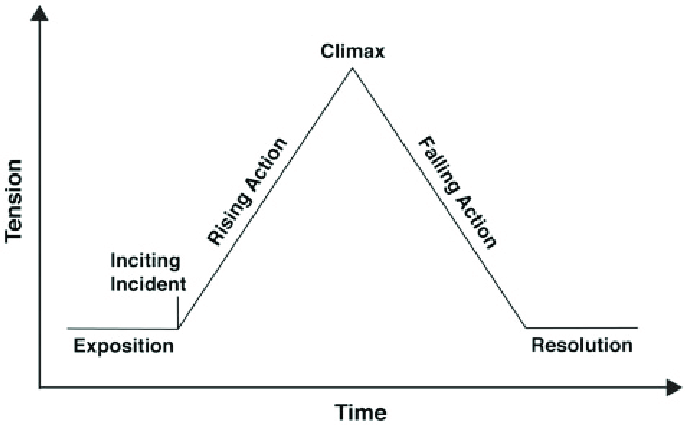As someone who wants to become a screenwriter, the words inciting incident even though they may seem strange now, shouldn’t be strange words to you after reading this post. This is because, for every story you intend to tell, you need the inciting incident for the story to be attention-grabbing. Including the inciting incident in your story changes the relaxed nature of your protagonist as it gives him or her a goal, which sets the story you want to tell in motion.
Have you ever watched an interesting movie without an inciting incident? No, I don’t think so. No reader wants to read a story where the protagonist’s life is smooth sailing. The challenge your protagonist faces is very important to the story you’re about to tell, and it starts with the introduction of the inciting incident. Let’s see a diagram from Research Gate.

From the Freytag Pyramid diagram above, you can see that a story remains flat until the inciting incident is introduced; that’s how powerful inciting incidents can be. You can also see from the diagram where and when to place inciting incidents in stories.
It’s important to know the perfect time to introduce your inciting incident, and this depends on the story you’re about to tell. If you don’t introduce your inciting incident at the correct time, you’ll make your audience lose interest in the story you’re about to tell as they will be asking themselves what the story is about; you wouldn’t want that. Let’s start by knowing what the words mean.
WHAT’S AN INCITING INCIDENT?
To get the concrete meaning of the words, let’s know the meaning of each word individually before combining them to see what they mean. According to the Oxford Language, to “incite” means to “stir up,” whilst an “incident” means “an event.” Thus, combining the meaning of the words means “to stir up an event.” Using the combined definition, let’s redefine an inciting incident to suit our screenwriting needs.
An inciting incident means “a stirred-up event that destabilises and gives the protagonist a goal.” This means that every event introduced in a story’s exposition should build beat by beat until the point where it blows up. From the Freytag Pyramid above, you can see where the beat-by-beat events blew up.
WHEN SHOULD IT BE INTRODUCED?
This is a question manual screenwriters ask. The reason for calling them manual screenwriters is that they seem to want a quick fix for everything. They want a drag-and-drop formula, not minding the story they’re telling. Some books, blogs, or even fellow screenwriters tell you to place it here and there, but have you looked at the story you’re telling to see if the inciting incident needs to be dropped at that time?
This is the reason why you watch some movies and notice that the screenwriter placed the inciting incident either too early or too late because he or she wants to follow a formula. Yes, formulas work for some things in screenwriting, but when it comes to placing the inciting incident in a story, the screenwriter must be connected to the story to know the right time to place it.
All that can be said about this is that it should be dropped at the end of the exposition, but there’s no fixed page to drop it. In some stories, the exposition is longer than in others. That’s the sole reason why you need to be connected with the story you’re about to tell. When you’re connected to the story, the story itself will tell you the right time to insert it.
THE WRONG INCITING INCIDENTS
These are the inciting incidents that aren’t loud enough. Even when it happens, it doesn’t destabilise the current state of the protagonist. They are the ones that occur without your reader realising it because the protagonist’s goal remains unclear. The correct inciting incident is the opposite of the previously mentioned.
EXAMPLES OF STRONG INCITING INCIDENTS IN STORIES.
1) The story of a politician’s son who falls in love with the daughter of his father’s political rival, and when he tells his father who he’s in love with, his father replies, “That will never happen.”
2) The story of a man who, after showing so much love to his wife and daughter, finds out the girl he has been calling his daughter doesn’t belong to him but to someone else.
3) A well-known pastor finds out his daughter is pregnant; he tells her to secretly abort the child, but she refuses to abort the child.
From these above-listed stories, you can see how loud the inciting incident is; you can see that the current relaxed state of the protagonist changes; and you can clearly see the goal of the protagonist. These are the kinds of inciting incidents your story should have. Whenever you wish to write a story, write a story with a very strong inciting incident.
